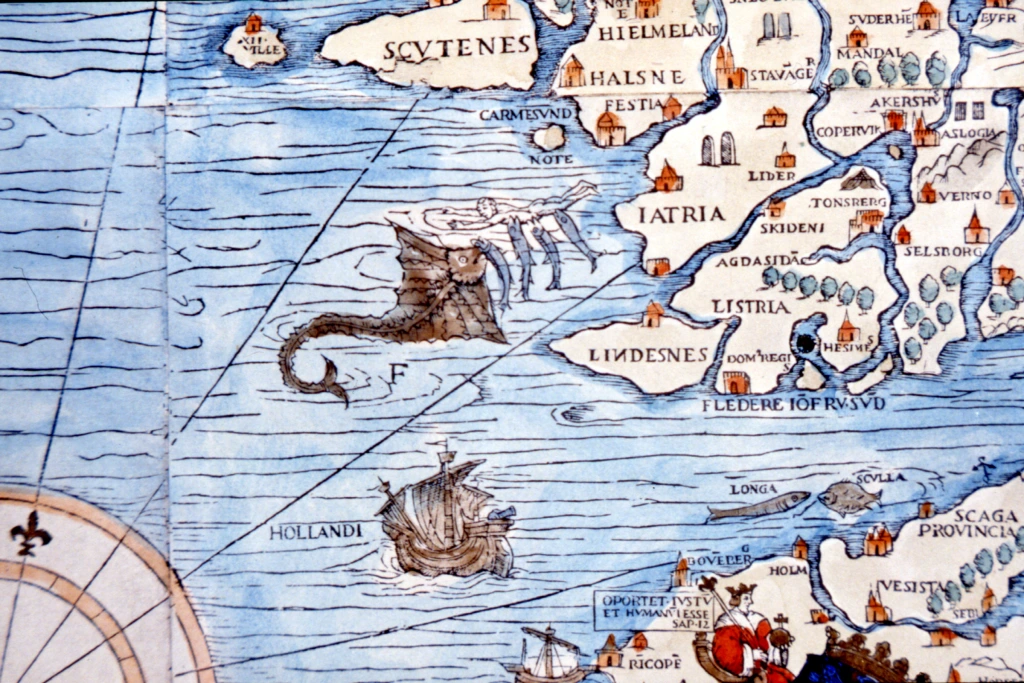The Carta Marina of Olaus Magnus, 1539

One of the most enigmatic artefacts that is displayed in the Orkney Museum is a copy of a large map of Scandinavia called the Carta Marina, created by Olaus Magnus and originally published in 1539. This is, of course, a copy. There are only two originals known to exist; one at the Bavarian State Library in Munich, Germany, and the other at the Upsala University Library, Sweden.
The map shows not only the countries, but a host of marvelous illustrations depicting scenes from daily life in the north lands. But what it is famous for are its sea monsters. Many of the sea monster images would be copied and used by later map makers. Not only did Olaus Magnus create the map, but he also wrote about the sea monsters. Each one is given a letter as a key, with a description given in the bottom, left hand corner.

Olaus Magnus was a Swedish Catholic priest who was sent by the Swedish Government on a diplomatic mission to Rome in 1523. He created his map in Rome between the years 1527-39. His prolonged stay was linked to his brother, Archbishop Johannes Magnus, who was in dispute with King Gustav I Vasa, who had him exiled from Sweden. Olaus’s map was based on earlier maps, classical writings and accounts of sea monsters from sailors. Olaus spent his time in both Rome and Venice. After his brother’s death in 1544 Olaus was made Archbishop of Uppsala in his place, but the Reformation had made it impossible for a Catholic Archbishop to return to Sweden. While in exile Olaus wrote a book to accompany the map, called ‘Historia de Gentibus Septentrionalibus’ (Latin: A Description of the Northern Peoples), which was published in Rome in 1555. It is from the natural history section of this book that much of the text used here is drawn, as he describes the sea monsters.






Where the Orkney Museum’s copy of the map came from, we don’t know. When ‘Tankerness House Museum’ (as the Orkney Museum was known from 1968-99) first opened in May 1968 it displayed the collection of the defunct ‘Orkney Antiquarian Society’. The first curator was the County Librarian, Evan MacGillivray (1908-87). Evan had close ties to Sweden and retired there. It is possible that he acquired a copy for the new museum. When the first professional curator (Museums Officer) Bryce Wilson was appointed in 1976 the map was already in place, with no documentation to say where it had come from.


The ‘prister’ is a large whale, thought to be a sperm whale. The sea unicorn is a narwhal. The strange creature, like a winged fish (in the top right of this photo), is not recorded in Olaus Magnus’s description or book. It is interesting to note that the nationality of the ships are given – here is a Norwegian ship.










“For it had a Hogs head, and a quarter of a Circle, like the Moon, in the hinder part of its head, four feet like a dragons, two eyes on both sides of its Loyns, and a third in his belly inkling towards his Navel; behind he had a Forked-tail, like to other Fish commonly.”
This fantastic creature was based on accounts of a strange animal that was published in an anonymous pamphlet in Rome in 1537. Some have attributed the pamphlet to Olaus Magnus himself, but there is no evidence to either support or deny this.




The Rosmarus, as Olaus calls it, is “…a kind of Whales, who shew their cruelty at first sight, and make men afraid of to see them; and if men look long on them, they will fright and amaze them.” It has been identified with the walrus.
The Kraken: “Their Forms are horrible, their Heads square, all set with prickles, and they have sharp Horns round about, like a Tree rooted up by the Roots… [the eye] is red and fiery coloured, which in the dark night appears to Fisher-men afar off under Waters, as a burning fire… one of these Sea-Monsters will drown easily many great ships provided with many strong Mariners.” This may be a giant squid, but legends of giant octopus were a staple for novelists for centuries.




Sea serpents are common in folklore and tales. In Orkney we have the folk tale ‘Assipattle and the Stoor Worm’, where the unlikely hero, the ‘ash-raker’, sails his stolen boat down the throat of the monster and sets its liver on fire. The dying monster’s forked-tongue gouges out a hole in the surface of the earth that fills wit water and becomes the Baltic Sea, while its teeth, knocked out during its violent death throws, creates the islands of Orkney, Shetland and Faroes. Its body curls up and it dies, forming Iceland, where its burning liver creates hot springs and volcanoes. All these places are featured in the Carta Marina. I hope this post inspires you to be creative and to visit the Orkney Museum to gaze on this wondrous map for yourself.
To make a donation to any of the museums please follow the link and support us. Thank you.
